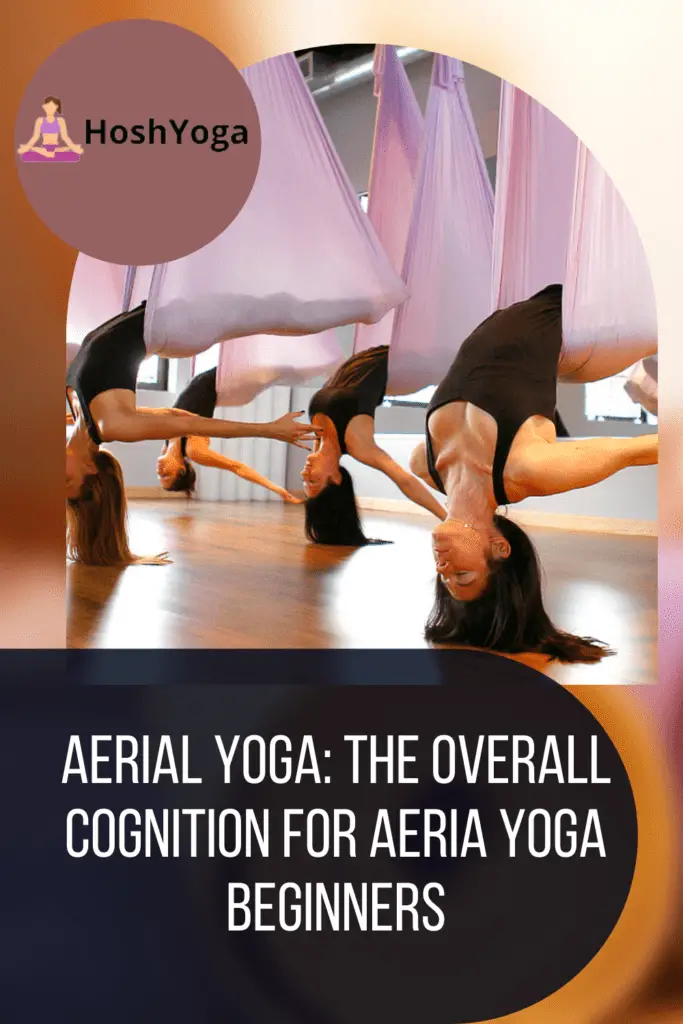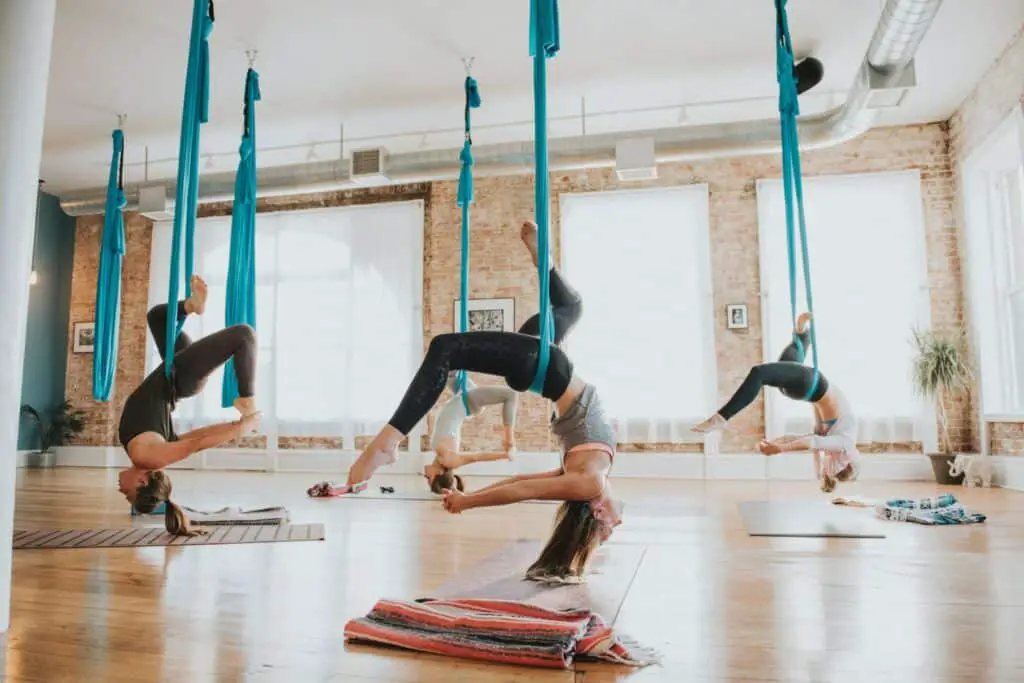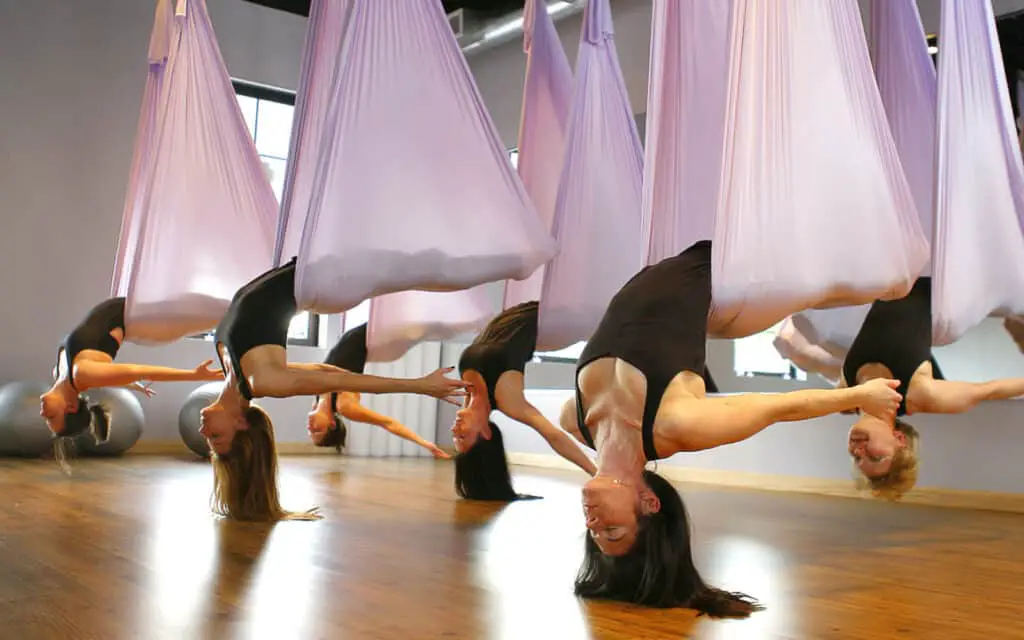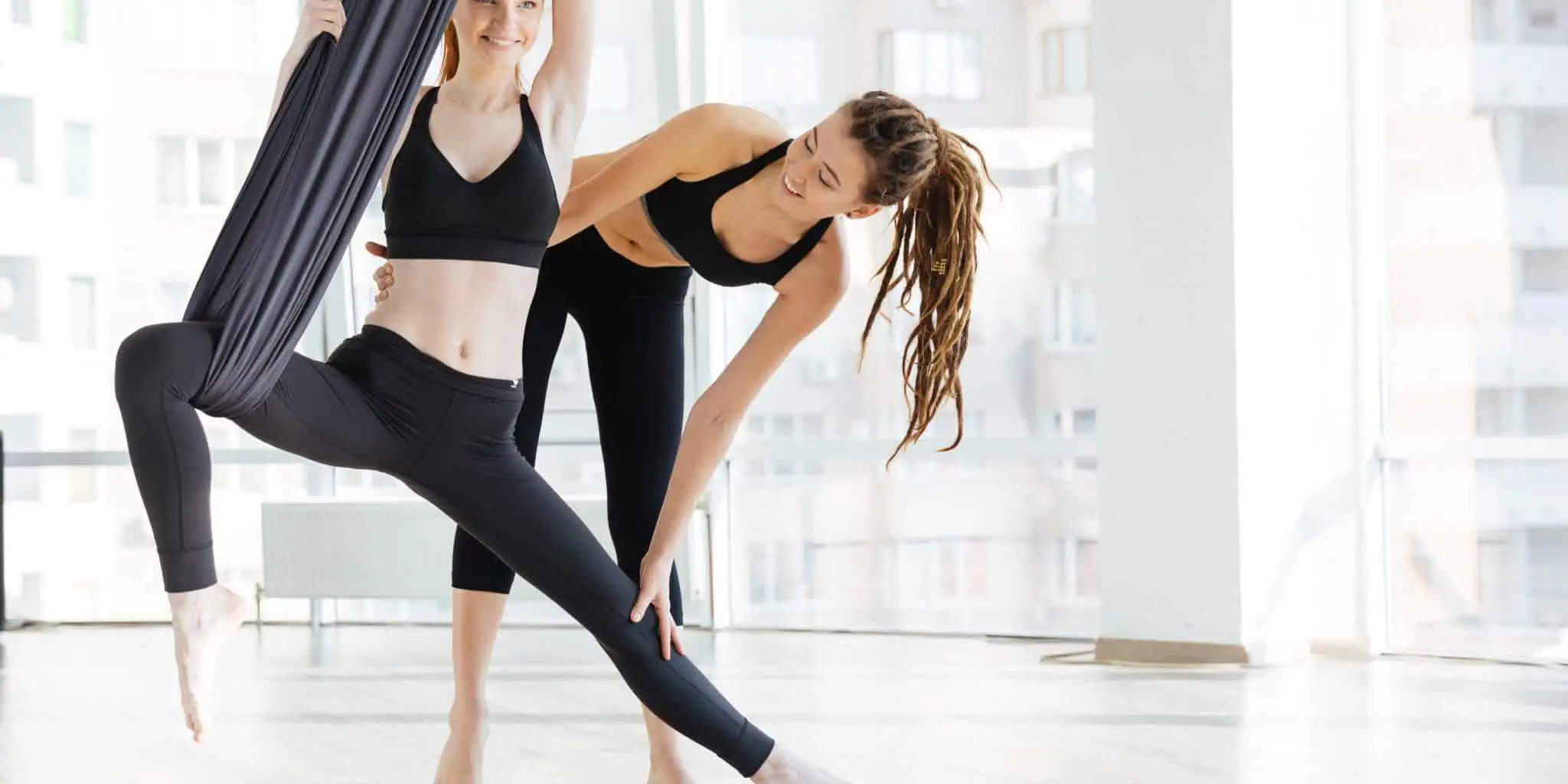Aerial Yoga, also known as Anti-gravity Yoga, is one of the most exciting forms of Yoga in the world. Aerial Yoga allows the practitioner to explore yoga poses in mid-air through the use of a hammock or other type of fabric. It is also rapidly growing in popularity; there are likely some excellent aerial yoga poses and aerial yoga classes near you.
If you want to know more about Aerial Yoga, its history, benefits, and differences from traditional Yoga, then continue reading.

What is Aerial Yoga?
Aerial Yoga is a unique type of hybrid yoga – A mixture of Yoga with another form of exercise. Yoga has been combined with practices such as HIIT and dance to create new experiences. Aerial Yoga is one of the most popular of these hybrid forms.
Aerial Yoga combines traditional yoga poses with a hammock or other type of fabric. While this variety of Yoga has historical antecedents, it has only recently gained mass popularity in Western countries.
Since the 1990s, the practice has attracted the attention of many due to several reasons. One of these is the many health benefits that come with practicing Aerial Yoga. We will discuss this more later in the article, but Aerial Yoga is an excellent form of low-stress exercise that improves flexibility and strength while protecting your joints.
However, Aerial Yoga does require quite a bit more equipment than a traditional Yoga practice. In particular, the hammock at the center of each class can be quite expensive compared to just a Yoga mat. You may also have some safety concerns, especially if you have watched advanced aerial yoga flows. However, by observing some basic safety procedures, you can be sure that you will be able to take part in this exciting practice safely.

The History of Aerial Yoga
While the use of equipment such as fabrics and rope has always been a part of certain Yoga practices, Aerial Yoga as we know it today can be traced back to the Yogi B.K.S. Iyengar. In the 1970s, he developed and popularized a form of Yoga that made use of straps and similar tools to help perform challenging poses. This Iyengar Yoga is the predecessor to modern Aerial Yoga.
Building off of this, Aerial Yoga as we know it today got started in New York City during the 1990s with a company known as Antigravity Inc. Founded by Christopher Harrison, this company was originally an aerial entertainment troupe. Acrobats hired by this company would perform aerial stunts in theatre and, eventually, on television, including the 2022 Winter Olympics.
Aerial Yoga was developed based on a combination of the warm-up exercises performed by the troupe and traditional yoga poses. All of these various trends were finally synthesized by Michelle Dortignac in the mid-2000s. By combining the traditional methods of Iyengar, the acrobatics of Harrison, and adding the iconic hammock and elements of pilates, Dortignac was able to create the most modern form of Aerial Yoga and one of the most popular in the world today.
Check out this article if you want a more in-depth look at the history of Aerial Yoga.

The Benefits of Aerial Yoga
As mentioned previously, there are many benefits to Aerial Yoga. These benefits are both physical and mental, with many practitioners reporting improved health in both of these areas.
We will start by discussing some of the many physical benefits that come with Aerial Yoga. These include:
- Spine Health Benefits. One of the main advantages of Aerial Yoga is the effect it has on your spine. If you work at a desk all day and don’t keep an eye on your posture, the joints in your spine may start to feel some strain. Aerial Yoga is a fantastic way to release this tension. The hammock will bear your body’s weight, giving your spine and joints a chance to decompress. In the long run, this practice can help stave off back pain.
- Flexibility. All forms of Yoga benefit your flexibility, but Aerial Yoga is especially good for beginners. If you are starting out and lack flexibility, Aerial Yoga is a great way to slowly improve your flexibility. As you improve your flexibility, you will find that you will suffer fewer injuries and greater physical strength.
- Improved Balance. Having a good balance is vital for your long-term health, especially as you age. Trips and falls can be debilitating as you get older. This is why the improved balance you get from aerial Yoga is so important. Many yoga poses require you to engage your core and leg muscles. As you develop these muscles, your balance will improve.

Aerial Yoga also has many mental health benefits, such as:
- Less Stress. Practicing Aerial Yoga is a great way to relieve stress. By giving yourself a full-body workout, you will find that, once you complete your class, your head will be much clearer.
- Improved Focus. Getting good at Aerial Yoga requires a huge amount of discipline. By consistently practicing, you will notice that focusing on other tasks outside of Yoga will also be easier for you.
Aerial Yoga vs Classic Yoga
While both traditional Yoga and Aerial Yoga are both fantastic ways to improve your physical and mental health, there are several differences between these different forms of Yoga. Just a few of these differences include:
- Balance Required. Aerial Yoga is both more and less challenging than Traditional Yoga. In Aerial Yoga, your hammock will help you stay balanced, especially for grounded poses, by bearing some of your body’s weight. However, Aerial Yoga does require a lot of balance as you try more complicated poses. Poses that take place off the ground, in particular, require excellent balance to perform and hold.
- Cost/Equipment of Starting. Traditional Yoga is, on the other hand, much more affordable to get into than Aerial Yoga. Aerial Yoga requires a lot more equipment; at the very least, you need a hammock and suspension hooks. Due to this fact, Aerial Yoga can be expensive to get into, especially when compared to Traditional Yoga.
- Bodily Impact. Aerial Yoga and Traditional Yoga have different effects on the body. As you are suspended when performing Aerial Yoga, your body will not bear the entirety of the weight that comes from different poses. Compared to Traditional Yoga, Aerial Yoga is less stressful for your body.

Safety Tips for Beginners
While Aerial Yoga is usually very safe, taking part in any sport runs some level of risk. By following these safety tips, you can keep yourself as safe as possible. These tips include:
- Consult with your doctor/instructor. Before you start any new exercise routine, consult with your doctor beforehand. They can provide you with medical advice appropriate to your current physical health. As a rule, pregnant women should not take part in aerial yoga without significant modifications. You should also try and contact the instructor beforehand. This will help you find out what you will be doing and if you will need to make any adjustments.
- Prepare for class. Before you attend a class, make sure to prepare. Wear appropriate clothing that will prevent you from rubbing against or getting caught in the hammock. Make sure not to eat too much and warm-up before class. While preparing, make sure to remove any of your loose jewelry so that it does not fall out as you start moving around.
- Check your equipment. You need to be able to trust your equipment to safely perform Aerial Yoga. Before you throw yourself into your first class, check that your hammock is securely held in place, that your hammock is free of tears or stretches, and that you have enough space to hang your equipment.
This video has some good safety tips if you are new to Aerial Yoga.
Aerial Yoga Gear
As mentioned previously, you will need a lot more equipment to take part in an aerial yoga class when compared to traditional yoga classes. This gear can be divided into a few categories that we will discuss now.
Firstly, clothing. If you are attending an aerial yoga class, you should get at least some of the following pieces:
- Fitted T-Shirt. It is up to you if you want short or long sleeves, either way, a t-shirt will help protect you from chafing or burns while transitioning between poses. Tucking in your t-shirt will also help it stay in place.
- Leggings can also protect you from chafing. Your leggings should, ideally, cover you from belly button to ankle. For men, meggings and bike shorts are great options.
When it comes to equipment, you will need the following:
- Aerial Yoga Hammock. This is the core piece of equipment in Aerial Yoga and is required to take part in any class. Hammocks usually come in a kit that includes everything you need.
- You will need to use Carabiners to secure your hammock and keep you in the air. Well-made carabiners are strong and can hold between 5,000 and 10,000 pounds without difficulty if secured.
- A ceiling hook, as the name suggests, keeps your hammock attached to the ceiling.
- Daisy chains are also really important for aerial yoga. You use daisy chains to adjust the height and form of your hammock.

Aerial Yoga FAQs
You will likely have many questions before your first aerial yoga class. We will attempt to answer some of the most common ones here.
Is Aerial Yoga Suitable For Beginners?
Aerial Yoga is excellent for beginners, especially beginner aerial yoga poses. Compared to traditional Yoga, it is less stressful for the body while still giving you a great workout. Aerial Yoga is also more accessible than traditional Yoga. If you are recovering from an injury or need to build up your strength/flexibility, Aerial Yoga can be a great way to exercise without much risk of further injury.
Can You Do Aerial Yoga At Home?
Yes, you can do Aerial Yoga at home. However, there are a few prerequisites. Firstly, make sure to attend a few classes before practicing at home. Doing so teaches you how to warm up properly and perform poses properly.
Aerial Yoga, while extremely safe, can be complicated initially. This is why you should seek out an instructor before diving in yourself. As well as safety concerns, your home must be suitable for aerial Yoga. If you do not have a space to safely install the equipment, it might be best to stick to classes.
How To Find The Aerial Yoga Class Near You?
If you are looking for Aerial Yoga near you, there are a few places you check. Firstly, look for any studios nearby and ask if they offer Aerial Yoga. Community centers and gyms may also offer Aerial Yoga, though this is less common. If you know somebody who teaches Yoga, ask them if they do private classes – this is another option if you aren’t comfortable doing Aerial Yoga in front of others.
What To Expect From Your First Aerial Yoga Class
If you are new to Aerial Yoga, here’s what you can expect from your first class. You will start with a simple warm-up to get the blood flowing. After this, your instructor will guide you through several basic poses. Following on, you will then move into your hammock and perform a variety of poses for the rest of the class.
Conclusion
As you can tell, Aerial Yoga is a rich and interesting form of Yoga that has many benefits. Aerial Yoga makes Yoga more accessible if you have limited mobility or past injuries. It also has many health benefits, including improved flexibility, spinal health, and balance. This form of Yoga is also incredibly safe. However, you need a few pieces of equipment to get started in Aerial Yoga.
If you have any questions, make sure to comment below.

